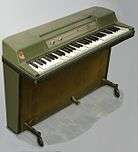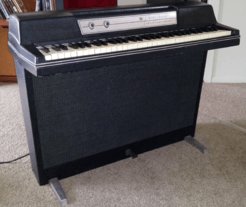Wurlitzer electric piano
 |
Opening of "What'd I Say"
The left-handed riffs of "What'd I Say" performed by Ray Charles on the Wurlitzer electric piano. |
| Problems playing this file? See media help. | |
 | |
| Other names | Wurly |
|---|---|
| Classification | Electric piano, keyboard |
| Inventor(s) | Benjamin Miessner |
| Developed | 1935, 1954 and 1984 |
| Builders | |
| Wurlitzer | |
The Wurlitzer electric piano, trademarked the "Electronic Piano" and referred to by musicians as the "Wurly", was one of a series of electromechanical stringless pianos manufactured and marketed by the Rudolph Wurlitzer Company of Corinth, Mississippi, U.S. and North Tonawanda, New York. The earliest models were made in 1954 and the last model was made in 1984. Since then the Wurlitzer electric piano sound has been recreated on digital keyboards, and the vintage models are sought by musicians and collectors.
General description
The Wurlitzer piano is usually a 64-note instrument whose keyboard range is from A an octave above the lowest note of a standard 88-note piano to the C an octave below the top note of an 88-note piano. Tone production in all models comprises a single steel reed for each key, activated by a miniature version of a conventional grand piano action and forming part of an electrostatic pickup system using a DC voltage of 170v. A mechanical sustain pedal similar to that of a conventional piano is fitted.
History
.jpg)
Inventor Benjamin Miessner had designed an amplified conventional upright piano in the 1935, and Wurlitzer used his electrostatic pickup design, but replaced the strings with struck steel reeds. The instrument entered production in 1954 as the EP-110, followed by the 111 and 112 of 1955, and continued to be produced in various forms until about 1982 when production of the EP-200A ceased.[1]
Variations
Most Wurlitzer electric pianos are portable models with removable legs and the sustain pedal attached via a Bowden cable; console, "grand" and "spinet" models were also produced with a permanently attached pedal. The early models sustain pedals actually attached through the side of the instrument, with the pedal eventually being connected directly under the unit in the late 1950s.

Portable models
The earliest versions were the "100" series; these had a case made from painted plywood and were fitted with a single loudspeaker mounted in the rear of the case. Apart from the 1950s models (110, 111, 112, 112A, 120), the portable Wurlitzer pianos featured a tremolo effect with fixed rate but adjustable depth. Models produced until the early 1960s used vacuum tube circuitry; the 140 was the first solid-state model, introduced in 1962. The model 145 was tube and came out around the same time as the 140 solid state pianos. Ultimately, after revisions designated with "A" and "B" suffixes, both were replaced in 1968 by the plastic-bodied 200, a much lighter instrument (56 lbs, without the legs or pedal) with two loudspeakers facing the player. This model was updated as the 200A in 1974 and continued in production into 1983. The 200 was available in black, dark "Forest Green", red or beige. The 200A was only available in black and avocado green. The white Wurlitzer sometimes seen being used by bands such as The Beach Boys, The Carpenters and Supertramp was a custom painted finish not made by the manufacturer. The last version to be introduced was the 200B in 1978; this was visually identical to the 200A but was designed to be powered by a pair of medium-tension (85v) rechargeable batteries; it had no internal speakers or amplifier.
Console models


One important role for the Wurlitzer piano was as a student instrument in school and college music labs, and non-portable console versions were made for this purpose. The teacher had a headphone and microphone to be able to listen into each student individually and talk to them without others hearing them. All students listened to each of their instruments through headphones. Up to 48 individual student instruments could be connected together. According to former Wurlitzer employee Bill Fuller, 75% of all universities used Wurlitzer piano labs in the late 1960s or early 1970s, and some facilities were still in operation as late as 2000.[1] Those usually seen resemble a beige or light green Model 200 mounted on a matching pedestal containing a loudspeaker, headphone niche and sustain pedal. On these models there is no tremolo (although later models simply have the facility disabled). Some of these models were given the designation 206/206A. Many console models have recently been modified to 200/200A specification for use on stage. Rarer than the student models are the teacher consoles (207/207Va/205V, etc.), featuring multiple monitor/mute switches and, in some cases the facility to add a large illuminated display panel ("Key Note Visualizer") operated via the keyboard.[2] Standalone classroom consoles were the 214/215 series, and home/stage consoles were the 203, 203W and 210. The last version was the 300, only available in the UK and EU.[3]
.jpg)
Note: Two knobs on the left are not the originals.
.jpg)
106P
A rare version, and the only known model not to have 64 keys is the 106P (P for "Pupil"), a 44-note classroom model with a plastic case, no controls, one loudspeaker and no sustain pedal. The 106P was available as a set of eight on a folding frame, forming a portable keyboard lab. They were attached by an umbilical to a full size teacher piano with controls to feature each pupil piano. This model appears to date from the early 1970s and was available in orange or beige.
Other models
.jpg)
Spinet versions
Since production began, small numbers of wood-cased spinet-style instruments were made for domestic use. These usually had an upright-piano style soft pedal (actually an electronic attenuator) as well as the sustain pedal. The mechanism of these pianos is identical to that of the contemporary portable version. The model 700 was the same amplifier and action as the portable model 120. The model 700 was produced circa 1959-1962. The model 720 was the spinet version of the 145 tube model; the slightly later 720B was a version of the solid state 140B. The model 720 and its variants were produced circa 1962-1965.
The rarest of all Wurlitzers was the Europe-only model 300, which was a spinet type piano based on the model 200A. This was the very last model produced and is even rarer than the model 270, butterfly grand. The model 300 looked similar to a modern digital piano.
Butterfly Baby Grand
The 200 uniquely had a domestic sister model 270 called the "Butterfly Baby Grand", a semicircular, walnut finish wooden-cased piano with twin quadrant-shaped lids angled above horizontally mounted 8" loudspeakers. This was among the last Wurlitzers produced, and is very difficult to find. It is also the heaviest Wurlitzer ever produced.
Sound
Compared with its erstwhile rival, the (Fender) Rhodes electric piano, the Wurlitzer has a less harmonically-complex, darker sound, while the Rhodes is more bell-like, containing high harmonics not as present in the Wurlitzer. This is seen by some as an advantage in a dense arrangement as the Wurlitzer can clearly be heard, occupying its own space without dominating. When played gently the sound can be quite sweet and vibraphone-like, sounding very similar to the Rhodes; while becoming more aggressive with harder playing, producing a characteristic slightly overdriven tone usually described as a "bark".
Maintenance issues
The reeds are notorious for metal fatigue caused by hard playing which can make them go out of tune and eventually break. This phenomenon can be minimized by having the action adjusted by a trained technician.
The reeds are tuned by filing off solder on the ends of them to make them go sharper and adding solder to them to make them go flatter. For those not handy with a soldering iron and in search of a quick tuning fix, beeswax may be added to the tip of the reed rather than solder.
New old stock and newly manufactured reeds are readily available from on-line specialists.
Users
Notable players
- Roger Hodgson
- Rick Davies
- Jeff Lynne
- Elton John
- Billy Joel
- Ray Charles
- Ray Manzarek
- Richard Carpenter
- Rick Wright
- Richard Tandy
- John Lennon
- Tori Amos
- Robert Lamm
- John Deacon
- Paul Davis
- Nicky Hopkins
- Earl Van Dyke
- Christine McVie
- Norah Jones
- Sun Ra
- Joe Zawinul
- Paul Rodgers
- Dennis DeYoung
- Donny Hathaway
- Avery Sunshine
- Ian McLagan
- Michael Omartian
- Larry Knechtel
- Booker T. Jones
- Garth Porter
- Bill Payne
- John Medeski
- Eddie Van Halen (run through a flanger and overdriven guitar amp for the intro to "And the Cradle Will Rock...")
- Jimmy Greenspoon
- Donald Fagen
Recorded examples
- Sun Ra — the first musician to record with Wurlitzer electric piano for his 1956 recording "Angels and Demons at Play"[5]
- Faces — "Stay with Me"
- Supertramp — "Dreamer",[5] "The Logical Song", "Goodbye Stranger", "Bloody Well Right", "Forever" and many others
- Queen — "You're My Best Friend"[6]
- Pink Floyd — "Breathe", "Time", "Money", "Shine On You Crazy Diamond" (Part 8) and "Have a Cigar"[7]
- American Football — "The One With the Wurlitzer"; the song features a Wurlitzer track, which also inspired the song's name.
References
- 1 2 Vail, Mark (2000). Vintage Synthesizers. Miller Freedman. pp. 276–277. ISBN 0-87930-603-3.
- ↑ "A Rare Breed Indeed: The Wurlitzer Student Model Classroom". The Workshop Blog. The Chicago Electric Piano Co. June 26, 2012. Retrieved 22 May 2014.
- ↑ "Wurlitzer Electric Piano models: a list.". paleophone.net. 8 July 2014. Retrieved 8 July 2014.
- ↑ Electronic Piano Series 200 and 200A Service Manual (PDF), DeKalb, Illinois: The Wurlitzer Company
- 1 2 Burgess, Richard James (2014). The History of Music Production. Oxford University Press. p. 76. ISBN 978-0-19-938501-0.
According to Jared Pauley of jazz.com, "Sun Ra was the first musician to record with an electric piano, the Wurlitzer, for his 1956 recording Angels and Demons at Play." Players of the statue of Ray Charles and Joe Zawinul also used Wurlitzer pianos. ... Supertramp's "Dreamer" is branded by the Wurlitzer piano sound, ...
- ↑ "You're My Best Friend". La bitácora de Queen. 7 February 2015. Retrieved 7 February 2015.
- ↑ http://www.witmatrix.com/images/WrightGear-rev156.pdf
| Wikimedia Commons has media related to Wurlitzer electric pianos. |